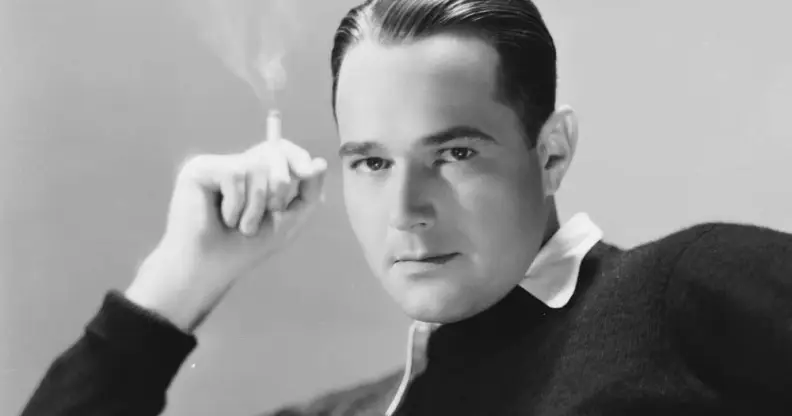Meet William ‘Billy’ Haines, ‘revolutionary’ gay silent movie heartthrob who gave it all up for love

Actor William Haines enjoyed a successful career as an interior decorator after he was forced to retire from acting because of his same-sex relationship. (Getty/John Kobal Foundation)
While many leading stars in the early days of Hollywood hid their truth from the world, William “Billy” Haines was proudly and openly gay.
Haines was one of the leading men in 1920s and 1930s Hollywood and was known for his roles as handsome, romantic, heterosexual leads.
Off-screen however, Haines was openly gay and refused to compromise or hide his sexuality – even at the cost of his acting career.
Born Charles William “Billy” Haines on 2 January 1900, he grew up as part of the Trinity Episcopal Church in Staunton, Virginia.
Haines first discovered a love of acting at an early age after spending hours watching early silent films in local theatres, according to the Hollywood Walk of Fame. He knew that he was gay from an early age, and he even ran away from home at the age of 14 with another young man who he referred to as his “boyfriend”.
The pair eventually got jobs working in a factory and opened a dance hall to supplement their income. The Hollywood Walk of Fame said this dance hall also potentially served as a brothel.
Haines returned home in 1917 to support his family – the the third child of a cigar maker and his wife, his two older siblings died in infancy but he had four surviving younger siblings.
But he soon left to live in New York City where he settled into the budding queer community in Greenwich Village.

William Haines (1900 – 1973), the Hollywood star of ‘Speedway’ from MGM. (Getty/Ruth Harriet Louise/Hulton Archive)
He worked a series of jobs before he entered into Goldwyn Pictures’ “New Faces of 1922” contest and was discovered by a talent scout. Goldwyn Pictures would eventually merge with other film studios to become Metro-Goldwyn-Mayer (MGM) company.
Haines was signed by the studio and travelled to Hollywood to begin his acting career.
The young actor’s career blossomed in the coming years thanks to hits like The Midnight Express, Brown of Harvard, Show People and Tell It to the Marines. Haines was soon ranked among the top 10 box office stars in Hollywood in the mid to late 20s and early 30s.
It was during this time that Haines met Jimmie Shields, a former sailor, while on a trip to New York in 1926, Slate reported.
Haines returned to Los Angeles with Shields in tow. He quickly moved his new boyfriend into his home and got him work as an extra at MGM studios.
Haines was open about his romantic relationship. Initially, it seemingly did not impact on Haines’ career or his status as a popular male leading man in films.

William Haines, the American leading man, combs his moustache with the prongs of a fork in a scene from ‘Show People’, directed by King Vidor for MGM. (Getty/Hulton Archive)
MGM’s Irving Thalberg, Haines’ studio boss, said in 1929 that the “idealistic love of a decade ago” was dead and that Haines was the new model of a male romantic star.
“William Haines, with his modern salesman attitude to go and get it, is more typical,” Thalberg said.
At the height of his fame, William Haines abandoned his career for love.
Several versions of the story have described how Louis B Mayer, film producer and co-founder of MGM, called Haines into his office in 1933 after the Motion Picture Production Code ushered in morality guidelines.
Mayer presented Haines with an ultimatum: break up with Shields and agree to a studio-arranged marriage, or lose his career.
And Haines chose Shields.
He reportedly responded “I am married” and walked out of the office.
With his film career over, William Haines decided to pivot and would eventually become one of Hollywood’s most in-demand interior designers.

William Haines (1900 – 1973) the Hollywood star of ‘Speedway’ from MGM. (Getty/Hulton Archive)
He became a part-owner of an antiques store in La Brea Avenue and used his famous connections to Joan Crawford, William Randolph Hearst and Marion Davies to further his career.
According to Town and Country, Haines became so well-known in Hollywood that directors incorporated his aesthetic in their films. A part of his personal art collection was hung on the walls of Tara, the fictional plantation, in Gone with the Wind.
He even decorated the home of Nancy and Ronald Reagan when the then-future-president became the governor of California.
Sadly, life was not peaceful for Haines and Shields. In 1936, they were severely beaten by a mob of white supremacists.
However, Haines and Shields remained together until Haines’ death from lung cancer in 1973, and Crawford described them as the “happiest married couple in Hollywood”.
Tragically, Shields could not cope with the loss of his partner of almost five decades. He died by suicide just months later, leaving behind a note describing how he couldn’t go on without Haines in his life.
William J Mann, author of Wisecracker: The Life and Times of William Haines, told Entertainment Weekly described Haines as “revolutionary” as he lived his life authentically “at a time when there were no role models”.
“He was an example of someone living with integrity and not letting himself be defined by others,” Mann added.
Mann said that Haines put “authenticity and integrity above career and ambition” and recognised that there are “more important things than material success”.
Suicide is preventable. Readers who are affected by the issues raised in this story are encouraged to contact Samaritans on 116 123 (www.samaritans.org), or Mind on 0300 123 3393 (www.mind.org.uk). Readers in the US are encouraged to contact the National Suicide Prevention Line on 1-800-273-8255.

